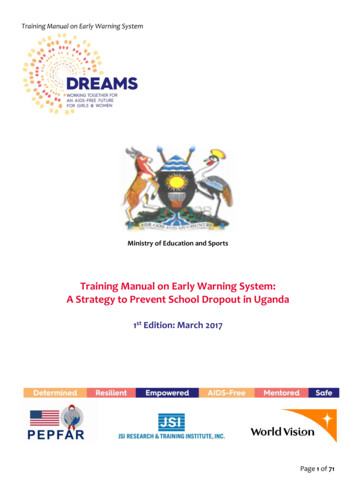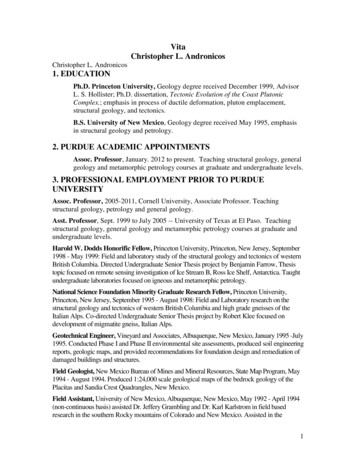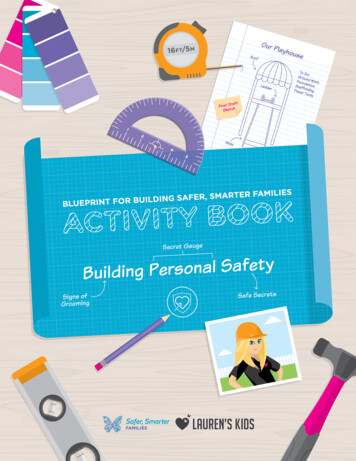
Transcription
Training Manual on Early Warning SystemMinistry of Education and SportsTraining Manual on Early Warning System:A Strategy to Prevent School Dropout in Uganda1st Edition: March 2017Page 1 of 71
Training Manual on Early Warning SystemTable of ContentsForeword . 3Acknowledgements . 4Acronyms . 5Introduction . 6The Situational Analysis of School Dropout in Uganda . 7 Overall Objective of the Manual . 7 Specific Objectives of the Manual . 7 Structure of the Manual. 8 Target Users of the Manual. 8 Duration of the Training . 8 Roll Out Process of the Training . 8 Symbols Used in the Manual . 9 Illustrations in the Manual . 9 Methodology. 9 Tips to the Trainers . 10 Material Preparation. 11 Venue Setting. 11 Dealing with Difference in Views . 11 Encourage Honesty and Openness – Create a Safe Space . 11 Evaluation of the Training Program . 11 Evaluation Scale . 12CLIMATE SETTING . 14MODULE 1: INTRODUCTION TO THE EARLY WARNING SYSTEM (EWS) . 16SESSION 1.1: DEFINING AN EARLY WARNING SYSTEM . 16SESSION .1.2: STAGES AND KEY ACTORS IN IMPLEMENTING THE. 20EARLY WARNING SYSTEM . 20MODULE 2: TRACKING AND RESPONSE TO AT RISK STUDENTS . 23SESSION 2.1: ON-GOING TRACKING OF STUDENTS AT RISK OF DROPPING OUT . 23SESSION 2.2: COMMUNICATION AND PARENTAL INVOLVEMENT FOR AT RISK STUDENTS . 30SESSION 2.3: CASE MANAGEMENT TO SUPPORT AT RISK STUDENTS . 34MODULE 3: SCHOOL-COMMUNITY ENGAGEMENT FOR AT RISK STUDENTS . 37SESSION 3.1: THE STAY IN SCHOOL COMMITTEE (SISC). 37SESSION 3.2: ROLES OF OTHER COMMUNITY ACTORS IN SUPPORTING AT-RISK STUDENTS 43SESSION 3.3: MONITORING THE EFFECTIVENESS OF THE EWS . 49MODULE 4: SAFE SCHOOLS AND SAFETY FRIENDS . 53SESSION 4.1: SAFE SCHOOL . 53SESSION 4.2: SAFETY FRIENDS . 57APPENDIX 1: ATTENDANCE TRACKING FORM . 61APPENDIX 2: PERFORMANCE TRACKING FORM . 62APPENDIX 3: BEHAVIOR TRACKING FORM . 63APPENDIX 4: HOME VISIT REPORT FORM . 64APPENDIX 5: SISC STUDENTS TRACKING FORM . 65APPENDIX 6: SISC MONTHLY ACTIVITY REPORTING TOOL .66APPENDIX 7: INTERVIEW GUIDE FOR EWS MONITORS . 67APPENDIX 8: TEACHERS’ SAFE SCHOOL CONTRACT .68APPENDIX 9: EWS MONITOR’S REPORTING TEMPLATE.69APPENDIX 10: TRAINING SCHEDULE FOR THE EWS . 70Page 2 of 71
Training Manual on Early Warning SystemForewordWorld Vision in partnership with the government of Uganda is implementing a Strengthening School –Community Accountability for Girls Education (SAGE) project under the DREAMS Innovation Challenge.The Determined, Resilient, Empowered, Aids-free, Mentored and Safe Women (DREAMS). The DREAMSInnovation Challenge is funded by the U.S. President ‘s Emergency Plan for Aids Relief (PEPFAR);Janssen Pharmaceutical NV (Janssen), Johnson and Johnson and ViiV Healthcare. This project runs fromOctober 2016 -September 2018 and aims to develop Determined, Resilient, Empowered, Aids-free,Mentored and Safe Women.The underlying principle of the SAGE-DREAMS project is that girls can attain their full potential whenthey are supported to remain and complete school. When girls remain and complete school, theyreduce the risk of HIV infection. This is because they get more empowered to make informed decisionsabout their sexual lives. The SAGE DREAMS project will increase awareness on Human Immune Virus(HIV) prevention and engage the larger community in supporting girls to achieve their hopes andaspirations using an adolescent peer- led Early Warning System approach.Adolescent girls in addition to the complex challenges contributing to school dropout, do not have theright set of supportive environment to stay in school. This has affected the level of retention for girls inschools and increased their vulnerability to HIV infection.The SAGE-DREAMS project through the Early Warning system approach strives to provide anopportunity to deliberately track, identify and support girls to remain and complete school in order todecrease their chances of HIV infection.I therefore call upon all stakeholders to join hands to support adolescent girls to remain and completeschool.Honorable Janet Kataaha MuseveniFirst Lady and Minister of Education and SportsThe Republic of UgandaPage 3 of 71
Training Manual on Early Warning SystemAcknowledgementsThis Training Manual is adapted by World Vision Inc. from the School Dropout Prevention Pilot (SDPP)Program that was a three-year multi-country program, funded by the US Agency for InternationalDevelopment (USAID), aimed at mitigating school dropout from primary and secondary school. Itsobjective was to provide evidence-based programming guidance to USAID missions and countries inAsia and the Middle East on student dropout prevention by piloting and testing the effectiveness ofdropout prevention interventions in four target countries: Cambodia, India, Tajikistan, and Timor Leste.World Vision Uganda’s Strengthening School-Community Accountability for Girls’ Education (SAGE)DREAMS project team contributed its technical expertise that informed adaptation of this trainingmanual from the USAID Early Warning System for Prevention of School Drop Out Learning Lab,Mississippi Early Warning System, District Guidance (August, 2016) and Trainer’s Guide forImplementing Early Warning Systems by Everyone Graduates, John Hopkins School of education et al(2016).We would like to acknowledge the Ministry of Education, and Sports (MoES) for their overall technicalguidance and support to have this manual in place for training teachers in Uganda. Special gratitudegoes to individuals from the following departments and Units:Directorate of Basic and Secondary Education: Secondary Department, Gender Unit, InstructionalMaterials Unit (IMU) Guidance and Counseling, Teacher Instructor Education and Training (TIET), andNational Curriculum Development Center (NCDC).Finally, World Vision Uganda extends its gratitude and dedicates this training program to all teachers inUganda, present and future, who will participate in this training and their efforts and commitment toprevent and respond to school drop out in schools and communities.Gilbert KamangaNational DirectorWorld Vision UgandaPage 4 of 71
Training Manual on Early Warning SystemAcronymsABCAttendance, Behavior and CourseperformanceLCVLocal Council 5AGAdolescent GirlsMGLSD Ministry of Gender, Labor and SocialDevelopmentAGYWAdolescent Girls and YoungWomenMoESMinistry of Education and SportsAIDSAcquired Immuno DeficiencySyndromeMOHMinistry of HealthBOGBoard of GovernorsMOJMinistry of JusticeDCDODistrict Community DevelopmentOfficerNCDCNational Curriculum Development CentreDEODistrict Education OfficerPTAParents Teachers AssociationDHODistrict Health OfficerSRBGVSchool Related Gender Based ViolenceDISDistrict Inspector of SchoolsTIETTeacher, Instructor Education andTrainingDPSWODistrict Probation and SocialWelfare officerToTTrainers of TrainersDREAMSDetermined, Resilient, AIDS Free,Mentored and SafeUDHRUniversal Declaration of Human RightsDREAMS- Determined Resilient EmpoweredICAids Free Mentored and SafeInnovation ChallengeUNICEF United Nations Children's FundEWSEarly Warning SystemUSAIDUnited States Agency for InternationalDevelopmentG4GGirls for GirlsVACiSViolence against children in schoolsGBVGender-Based ViolenceVHTVillage Health TeamsHCTCounselling and TestingWVIWorld Vision InternationalHIVHuman Immune VirusWVUWorld Vision UgandaIMUInstructional Material UnitWVUSWorld Vision USLC1Local Council 1YFRHSYouth Friendly Reproductive HealthServicesPage 5 of 71
Training Manual on Early Warning SystemIntroductionThis Manual has been developed by referring to and incorporating learning and recommendations fromthe School Dropout Prevention Pilot (SDPP) Program. This Program was a three-year multi-countryprogram, funded by the US Agency for International Development (USAID), aimed at mitigating schooldropout from primary and secondary schools. Its objective was to provide evidence-based programmingguidance to USAID missions and countries in Asia and the Middle East on student dropout prevention bypiloting and testing the effectiveness of dropout prevention interventions in four target countries:Cambodia, India, Tajikistan, and Timor Leste.World Vision adapted the Theory of change for the School Dropout Prevention Pilot (SDPP) program forthe SAGE-DREAMS project because this pilot has been proven to work and it is a good model to replicatein other countries.Figure 1: School Dropout Pilot Program Theory of Change for Early Warning Student Attitudes andAspirationsParent SupportTeacher Prevention Practices andSupportTeacher and Parent — Knowledge and AwarenessThis model involves a process of designing and implementing an Early Warning System through: Increasing the knowledge base on the early warning signs of school dropout amongst teachers andparents in order to generate parents and teachers’ prevention practices Support through monitoring attendance, behavior and performance of students.1Source: USAID Early Warning System for Prevention of School Dropout project (Aug, 2016)Page 6 of 71
Training Manual on Early Warning SystemThis collective support by teachers and parents stimulates the students’ attitudes and aspirations toattend school, do their homework and perform well in order to achieve their dreams.The model is centered on monitoring the attendance, behavior and performance of students as keypredictors which are early warning signs for school dropout. It is built on the understanding that schooldropout is a process that can be curbed if teachers, school administrators and parents work togetherand are aware of the early warning signs. In order to address drop out in the targeted schools, the SAGE– DREAMS project adopted the School Dropout Pilot Project model from which this training manual hasbeen developed.The Situational Analysis of School Dropout in UgandaAccording to the MoES EMIS 2015 report, 65% of girls who complete primary seven join the first year ofSecondary Education (S.1); 34% girls complete Senior 4 of an overall 40 % S4 completion rate. The reportalso indicates that only 30% of the girls who complete S.4 transition to S5. Some of the girls join certificatecourses in the technical and vocational institution, nursing and midwifery and Primary Teacher trainingColleges. However, overall there are fewer numbers of girls in higher institution of learning compared tothe boys. This means that many girls drop off at the lower levels of the education cycle. This conditionhas been attributed to poverty and socio-economic factors such as: lack of basic needs, negativeinfluences from teachers and communities, sexual abuse, violence and lack of guidance from parents.2Overall Objective of the ManualThe Manual has been developed to train Trainers of Trainers (ToT) who will train teachers on the conceptof the Early Warning System as a strategy for preventing school dropout. The teachers will in turn usethe Manual to train the Stay in School Committees (SISC) sometimes referred to as the “Early WarningTeam” (EWT) which is a structure that will be at the forefront of implementing the Early Warning System(EWS).Specific Objectives of the Manual 2To train teachers on the EWS strategies and methodologyTo facilitate tracking of and response to students at risk of dropping out of school.To facilitate understanding of key actors in supporting children at risk of dropping out of school.Education Management Information System (EMIS) 2002-2015Page 7 of 71
Training Manual on Early Warning System To equip teachers and administrators with skills for promoting a safe school To introduce the safety friends as a peer support mechanism for safety of students to and fromschool.Structure of the ManualThe Manual is comprised of 4 modules highlighted below: Module 1: Introduction to the Early Warning SystemModule 2: Tracking and response to at risk studentsModule 3: School-community engagement for at risk studentsModule 4: Safe schools and safety friendsEach session consists of different sections and these includes: Introduction Duration Session Competences Methodology Materials Needed Session Activity Facilitator’s Notes Wrap UpTarget Users of the ManualThis Manual will be used by: SAGE-DREAMS project staffTrainers of TrainersTeachers who will use it at different levels to disseminate the Early Warning System methodology andstrategy for the prevention of school dropout among adolescent girls. The Stay in School Committee (SISCs) will use this manual as a reference document from time to timeto guide them in the implementation of the EWS. All the tools for implementing the EWS are found inthe manual. An EWS monitoring teamDuration of the TrainingThe training content in this manual is expected to be delivered in three days. The project will train ToTsfor each target district. The ToTs will roll out this content to teachers targeting at least 6 teachers perschool. The teachers will then train the SISCs in their respective schools who will use this information tosteer the implementation of the EWS.Roll Out Process of the TrainingEventTarget AudienceReview and adoption of the EWS training Officials from the MoESmanualDREAMS national focal personOfficials from NCDCTraining Trainers-of-TrainersSelected trainers per districtPage 8 of 71
Training Manual on Early Warning SystemRoll out training to teachersTraining of the SISCs6 selected teachers per schoolAll SISC membersSymbols Used in the tenciesIllustrations in the ManualThe illustrations in this manual is purely for learning purposes. The names of characters in the case studiesare not real names nor are the school names. The figures in performance and attendance sample trackingsheets are not real either. They have been crafted for study purposes only.MethodologyThe Manual uses different participatory methodologies briefly described below:BrainstormingA brainstorm is an exploration of ideas and a great way to open a topic for discussion. During brainstorming, no one should judge or place a value on an answer someone else gives. Each answer is simplyrecorded on flipchart paper or a chalkboard for the entire group to see. This activity encouragesparticipants to expand their thinking about an idea and look at a topic from different angles andperspectives. The facilitator makes relevant clarifications.Group DiscussionGroup discussion elicits responses from participants on a particular topic or issue and provides manyteachable moments to enhance knowledge or correct misinformation. The effectiveness of the groupdiscussion often depends on the use of open-ended questions, which are questions that go beyond asimple “yes” or “no”. These questions seek to bring out feelings or thoughts about a topic or anactivity.“What did you learn from this activity?” is an open-ended question because it invites participants toshare their thoughts and reactions. “How did that activity impact you?” would be another example ofan open-ended question.“Did you learn anything?” is not an open-ended question, as the participant can simply say “yes” or“no.” “Does that make sense?” is also not an open-ended question.Another strategy to ensure effective group discussions is to communicate acceptance and validatefeelings. People are far more likely to share their feelings and ideas if they know they will not be judgedor criticized for expressing themselves or if others do not feel the same way they do.Page 9 of 71
Training Manual on Early Warning SystemRole-PlayRole-play is an effective method for practicing and modeling new skills. Since role-play can potentiallybe emotional, it is very important to emphasize that participants are playing characters and notthemselves. Role-plays also provide an opportunity to remind participants of agreed-upon ground rulesand group norms. It is important to encourage participants to role-play realistic situations. Role-playprovides the opportunity to experience a real-life situation without taking real-life risks.Case StudyCase study helps to create a “real situation” of a topic under study. The facilitator will use this methodto assess the level of understanding of participants on a topic under discussion. It will also be used toreinforce what was learned.Vote with Your FeetParticipants express their opinions and feelings on issues by going to a pre-designated sign or point inthe room that represents their feelings on that subject.Learning Games / Energizers / IcebreakersEnergizers or icebreakers are games to help participants relax, have fun and reconnect with each other.At the beginning of each session or meeting, lead participants in a warm-up. Games can also be used atthe end of the day or between sessions and activities to lighten the mood and give participants anopportunity to relax after a difficult or intense session/day. You can ask participants to come up with icebreakers as a way of increasing their level of participation in the training session.Other methodologiesGallery WalkGallery walk involves participants moving to designated places of the training room to learn fromdisplayed information in the different places.Question and AnswerThe facilitator can engage participants using question and answer approaches. This is mainly aimed atassessing the level of participants’ knowledge at the beginning of a topic or assess the level ofunderstanding after delivering a topic.Facilitated DiscussionsThis is a method used by the facilitator to guide the delivery process by explaining key information andoccasionally engaging participants through questions and answers.Tips to the TrainersThere is no single method that can be used in isolation to facilitate a training program. Each facilitatorhas a different style; different groups have different needs. A trainer needs to use different methods todeliver a good training program.A good facilitator must exhibit the following: Treat participants as people with information and skills to share, rather than take himself or herselfas the only expert in the room. Think of everyone participant as learning from each other and of himself or herself as guiding theprocess rather than thinking of the participants as empty bowls to be filled with knowledge from thefacilitator. Believe that people learn by doing, experiencing, practicing and feeling, rather than by memorizing,repeating and recording information.Page 10 of 71
Training Manual on Early Warning System See many possible answers to a situation or question rather than only one right answer. Think it is important for all to participate and be involved in the learning process rather than thinkingof control as better.Material PreparationIt is strongly advised that the trainer prepares all materials in advance and have them ready in advance.This will help to run all lessons and activities smoothly. Some activities will require handouts that can bephotocopied and distributed prior or after activities. It is recommended to use of a chalkboard or flipcharts to write definition or illustrate concepts, if printed copies are not available.Venue SettingThis Training Program is designed to be highly participatory, filled with participatory group reflections,discussions and brainstorming, many of which will result in concrete products. Organize tables andchairs at a training venue in a small “U” shape or oval shape where possible. If the training venueallows, display results of the group work and participatory activities on the walls to refer back to theknowledge, demonstrate the links between the activities, and acknowledge participants’ hard workand commitment.Dealing with Difference in ViewsIt is important to set an atmosphere in which people can share different views. Participants should notfeel they all have to agree with each other. The important thing for the trainer is to open the questionsfor discussion, summarize the different views expressed, and to ask participants to think about possibleconsequences for a range of actions. It is not the trainer’s job to recommend a particular opinion.However, the facilitator is encouraged to provide correct and reliable information.Encourage Honesty and Openness – Create a Safe SpaceEncourage participants to be honest and open, and promote sharing of personal experiences andstories from classrooms and school settings. Further, trainers are seen as role models and they canshare personal examples with the participants on how they survived dropping out of school. Trainingsessions should a safe space, where views can be expressed without fear of judgment and difficulttopics can be addressed without shame.Evaluation of the Training ProgramSelf-reflection and feedback from others are useful to help improve your facilitation skills and theprogram overall. You should conduct some kind of evaluation after each session or at the end of eachday. There are several ways to find out how the program is progressing. Below are some suggestions:Self-assessment: Questions to ask yourself What went well? What was difficult? Did I achieve the objectives of the session? How will I do it differently next time? What did I learn from today’s session that I can apply in the upcoming sessions?Page 11 of 71
Training Manual on Early Warning SystemEvaluation ScaleVery HappySomewhat HappyNot HappyThe facilitator will have printed copies of the evaluation scale and ask participants to tick or placestickers in the box that indicate how they feel.2. ObservationIf you are working with another person, take turns to observe how the group is working together andparticipating in the activities and discussions. If you are facilitating the sessions alone, you can stillobserve how the group is reacting and working together. Be sure to observe the following: Are all the participants attending the program? Who is actively participating? Are there any participants who are keeping quiet? Who talks the most and who talks the least? Are participants listening to each other? Are participants working together or splitting up into smaller groups? What is the mood of the group? Do participants seem bored or interested in the activities? Does anyone seem upset or embarrassed by the activities? How do participants respond when others voice their opinions? Are participants giving feedback to each other and the facilitator during the sessions?3. Feedback from ParticipantsInvite participants to share their views on the sessions. You could go around the room at the end of theday and ask everyone to say something, or you could invite participants to volunteer to share one thingthey liked about the day’s session and one suggestion for improvement. Below are some questions forgathering feedback: What is the most important thing you learned in this session? What did you enjoy most about this session? What did you find difficult about this session? What suggestions do you have for improving the next session? Are there any questions or issues we did not cover that you would like to discuss?TIPS FOR A SUCCESSFUL TRAINING PROGRAM Be familiar with the entire manual before beginning the programBe familiar with all the sessions before delivering the sessions and have materialsprepared beforehand.Anticipate any issues that might arise during more emotionally demanded sessionse.g. sessions that discuss sexual abuse.Page 12 of 71
Training Manual on Early Warning System Review the objectives with participants at the beginning of each sessions Always try to provide local examples and make the activities relevant to theparticipants’ daily lives and concerns When possible work from the known to the unknown and from easy to difficulttopics Create a “parking lot” for issues that arise during the sessions but are not relevantto the session objectives. These issues can be discussed at another time or linkedto other activity sessions Plan for ice breakers and energizing activities. They can be a great transition fromone activity to another or used when energy in a group is low Capture the important points during the discussions, list them on a flip chart for useduring the summary and wrap-up activities Consider asking a co-facilitator to assist. Connect new information or content to what the participants already know andexplain its relevancy to their current situation both individually and as a collectivegroup Be sure to end sessions on a positive note with a clear take away message. When appropriate identify next steps or possible solutions to challenges Encourage participant to answer questions.Page 13 of 71
Training Manual on Early Warning SystemCLIMATE SETTINGIntroductionThis session provides participants and facilitators an opportunity to learn more about one another andto establish trust while providing an overview and the goals of Training Program. The session will giveparticipants an idea of the “bigger picture” and explain how the program is set up, including a discussionof when participants will be meeting. It will provide participants with a clear picture of what is expectedof them in the program and give them chance to express their expectations of the training program.The session introduces the training program to the participants.Activity 1: IntroductionActivity 2: Expectations and Ground RulesMaterials Needed Chalkboard or flipchart Masking tape Sticky notes A ball1: Participants introduction and introduction of the Training ProgramDuration: 30 MinutesFacilitator’s Guide Facilitators welcome the participants and introduce themselves as trainers. Facilitator asks participants to form a circle for the introduction exercise. Facilitator gives participants instructions of how the introduction will be conducted asbelow: A ball will be thrown and whoever picks it introduces themselves by mentioning thefollowing:o Their name, school, roles at the school and what they like2: Introducing training objectives and generating participants’ expectations and fearsDuration: 30 MinutesFacilitator’s Guide Ask participants to remain in the circle Hand sticky notes of two different colors to each participant Ask participants to write their expectations on one sticky notes and fears on another Ask participants to post their ex
Ministry of Education and Sports . A Strategy to Prevent School Dropout in Uganda 1st Edition: March 2017. Training Manual on Early Warning System . Program that was a three-year multi-country program, funded by the US Agency for International Development (USAID), aimed at mitigating school dropout from primary and secondary school. .










